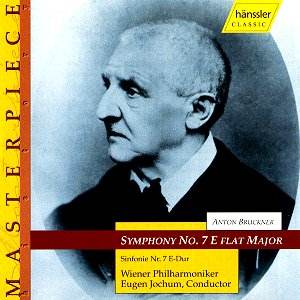This
performance of Bruckner’s mighty Seventh originates from the SWR
archives. Hänssler claim this is the first time it has been
available (presumably they mean on CD, as they give the original
Telefunken 78 numbers, SK3000/7 on the inside front cover!), and
so this is clearly a valuable historical document.
Eugen
Jochum’s Bruckner interpretations have caused some controversy,
frequently being contrasted with Furtwängler’s more architectural
approach. A stop-start account can fall flat on its face, but
luckily there are enough redeeming qualities here to make this
Seventh a fascinating experience. There are famous studio accounts
from Dresden and Berlin by Jochum (EMI and DG respectively). Here
Hänssler provide what is effectively a supplement to these,
an early 1939 performance with the Vienna Philharmonic (it also
complements Mravinsky’s 1967 Leningrad performance recently reviewed
on this site: http://www.musicweb-international.com/classrev/2003/July03/Mravinsky.htm).
The
transfer is in general acceptable, the only major stumbling block
being a tendency to crowd at climaxes. In addition, the third
movement Scherzo suffers from problems of level. The opening lower
strings are all but inaudible, meaning that if one cranks up the
volume, the louder passages become at best uncomfortable (TRACK
3).
The
first movement is expansive (listen to the initial ascending horn/cello
arpeggiation, TRACK 1). It is soon clear that there is a remarkable
control of the orchestra in evidence here - but that control is
put at the service of some very impulsive accelerandi (from
11’ onwards there is almost the impression of skidding out of
control!).
The
famous Adagio is the redeeming factor in this account (TRACK 2).
There is a real warmth to the sound that manages to crawl its
way across the decades, coupled with Jochum’s innate harmonic
sensitivity. Coming complete with cymbal crash, there is a predominant
confidence that only falters again at around the 11 minute mark.
It is almost worth the price of the disc for the lead in to the
entrance of the Wagner tubas (who, alas, enter rather unsubtly
at 21’46 and mar the moment). In addition to the problem of sound
level mentioned above, the Scherzo and Trio suffers from an overly
serious slant. Jochum attempts to whip up some excitement prior
to the Trio, which he milks too much (a sign of the times, perhaps:
there are even some syrupy portamenti). Ensemble between
horns and violins is not entirely accurate, either.
The
finale is brisk, but not so breezy. Although initially it feels
that there is an underlying intensity proceeding in tandem with
Jochum’s chosen pulse, in the final analysis the cumulative energy
inherent in this score fails to appear. Distortion in the heftier
moments does not help.
An
interesting document, then, but definitely not a first choice.
Documentation
deserves a comment or two. The booklet notes are not booklet-bound
at all: there is a ‘free download’ at www.haenssler-classic.de.
Very generous of them. Assuming one has internet access and printer,
there is still the question of fitting cumbersome A4 sheets in
to one’s slip-case (also, the notes were not yet up when I received
my review copy, resulting in a delay for this review).
It
really does feel as if one is handling half a product.
Colin
Clarke
